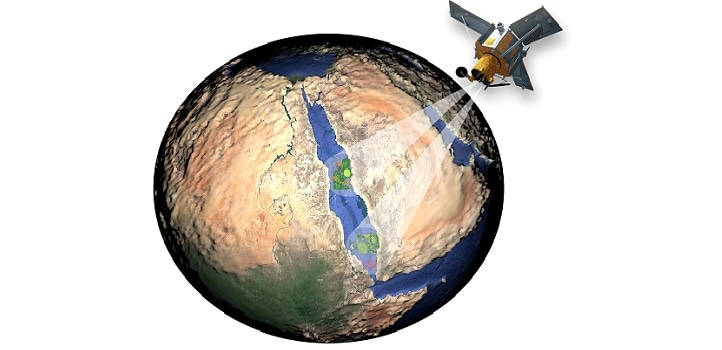May 29 2019
KAUST researchers have developed a novel technique that could be used for detecting toxic algal blooms in the Red Sea from satellite images.
 A schematic diagram shows how satellites detect algal blooms. (Image credit: 2019 KAUST)
A schematic diagram shows how satellites detect algal blooms. (Image credit: 2019 KAUST)
This new remote sensing method may ultimately pave the way for a real-time monitoring system to help sustain the key ecological and economic resources of the Red Sea.
Tracking toxic blooms with the help of conventional in-situ techniques is both labor intensive and expensive, but this usually needs collaboration across borders. Remote sensing techniques, which are based on satellite data, are low-cost methods that also provide the chance of continuous monitoring and upfront observation of the temporal and spatial extent of the algal bloom. Conversely, suitable analytical methods are required to expose the algal blooms in satellite data.
“So far, no satellite algorithms have been developed to monitor harmful algal blooms in the Red Sea region,” stated Ibrahim Hoteit’s PhD student Rajadurai A. Gokul. Along with coworkers at KAUST, as well as in the UK and Yemen, Gokul extended current techniques to allow imagery from NASA’s MODIS-Aqua satellite to be used for identifying toxic algal blooms in the Red Sea.
Satellite images of a number of algal blooms were used by the researchers as training data to modify their analysis model. Subsequently, they validated the model by applying it to examine the data obtained during other algal blooms. The analysis model effectively identified the algal blooms in the validation data; moreover, predictions of their spatial extent as well as the concentration of chlorophyll A corresponded with the observations made in the domain.
However, a major difficulty for the researchers was to create an atmospheric-correction algorithm to handle the recurrent aerosols and dust storms over the Red Sea coming from the surrounding deserts. Through this correction, the team was able to retrieve more precise ocean-color data as well as reflectance measurements at varied wavelengths, which were used for detecting algal blooms and establish which kinds of species were actually involved.
The researchers are now applying this method to examine traditional satellite data to rebuild and examine earlier algal blooms so as to interpret their annual and seasonality variability. More studies will be required to allow the analysis model to identify algal species that were not included in this study.
“Our results suggest real potential for developing a real-time remote sensing algorithm to detect harmful algal bloom events in the Red Sea and issue timely alerts for emergency management,” stated Gokul.
With further refinement, this will act as a useful resource in efforts to sustainably control the coastal zone of the Red Sea and its key role in the regional economy through tourism, fisheries, and aquaculture.